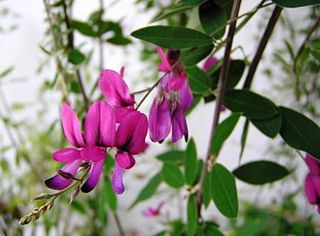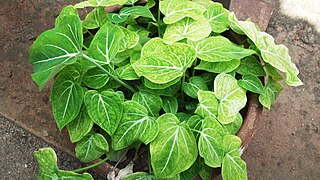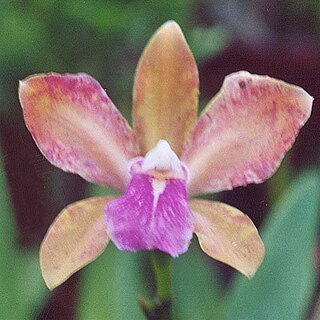
Sorghum is a genus of about 25 species of flowering plants in the grass family (Poaceae). Some of these species are grown as cereals for human consumption and some in pastures for animals. One species, Sorghum bicolor, was originally domesticated in Africa and has since spread throughout the globe. Seventeen of the 25 species are native to Australia, with the range of some extending to Africa, Asia, Mesoamerica, and certain islands in the Indian and Pacific Oceans. One species is grown for grain, while many others are used as fodder plants, either cultivated in warm climates worldwide or naturalized in pasture lands. Sorghum is in the subfamily Panicoideae and the tribe Andropogoneae.

A bicolor cat or piebald cat is a cat with white fur combined with fur of some other color, for example black or tabby. There are various patterns of bicolor cat. These range from Turkish Van pattern through to solid color with a throat locket.

Lespedeza is a genus of some 40 species of flowering plants in the pea family (Fabaceae), commonly known as bush clovers or Japanese clovers (hagi). The genus is native to warm temperate to subtropical regions of eastern North America, eastern and southern Asia and Australasia.

Loxocemus bicolor, sole member of the monotypic family Loxocemidae, is a species of python-like snake found in Mexico and Central America. No subspecies are currently recognized. Analyses of DNA show that Loxocemus is most closely related to the true pythons and the sunbeam snakes.

Acanthophippium is a genus of orchid with thirteen species. The name of this genus is derived from the Greek words acanthos ("spiny") and ephippion ("saddle"), referring to the saddle-like labellum of the plants.

Theobroma is a genus of flowering plants in the mallow family, Malvaceae, that is sometimes classified as a member of Sterculiaceae. It contains roughly 20 species of small understory trees native to the tropical forests of Central and South America. The generic name is derived from the Greek words θεός (theos), meaning "god," and βρῶμα (broma), meaning "food". It translates to "food of the gods."

Caladium is a genus of flowering plants in the family Araceae. They are often known by the common name elephant ear, heart of Jesus, and angel wings. There are over 1000 named cultivars of Caladium bicolor from the original South American plant.

The red-tailed black shark, also known as the redtail shark and redtail sharkminnow, is a species of freshwater fish in the carp family, Cyprinidae. It is endemic to Thailand and currently critically endangered, but common in aquaria, where it is prized for its deep black body and vivid red or orange tail. The red-tailed black sharks seen in the aquarium trade today are all captive bred.

The black-faced grassquit is a small bird. It is recognized as a tanager closely related to Darwin's finches. It breeds in the West Indies except Cuba, on Tobago but not Trinidad, and along the northern coasts of Colombia and Venezuela.

The Sahara Desert ant is a desert-dwelling ant of the genus Cataglyphis. It primarily inhabits the Sahara Desert and is one of the most heat tolerant animals known to date. However, there are at least four other species of Cataglyphis living in the Sahara desert, for example C. bombycina, Cataglyphis savignyi, Cataglyphis mauritanicus and C. fortis. Also, specimens of C. bicolor have been found well north of Sahara.

Sorghum bicolor, commonly called sorghum and also known as great millet, durra, jowari / jowar, or milo, is a grass species cultivated for its grain, which is used for food for humans, animal feed, and ethanol production. Sorghum originated in Africa, and is now cultivated widely in tropical and subtropical regions. Sorghum is the world's fifth-most important cereal crop after rice, wheat, maize, and barley, with 59.34 million metric tons of annual global production in 2018. S. bicolor is typically an annual, but some cultivars are perennial. It grows in clumps that may reach over 4 m high. The grain is small, ranging from 2 to 4 mm in diameter. Sweet sorghums are sorghum cultivars that are primarily grown for forage, syrup production, and ethanol; they are taller than those grown for grain.

Lupinus bicolor is a species of lupine known as the miniature lupine, Lindley's annual lupine, pigmy-leaved lupine, or bicolor lupine.

Acanthophippium javanicum is a species of orchid and the type species of its genus. It is found in West Malaysia, Borneo, Java, Sumatra and New Guinea.

Cattleya bicolor is a species of orchid found in Brazil.

Cymbidium bicolor, the two-colored cymbidium, is a species of orchid found in South China to Tropical Asia.

Drosera bicolor is an erect perennial tuberous species in the genus Drosera that is endemic to Western Australia. It produces a basal rosette of leaves similar to that of D. peltata and the stem grows to 11 cm (4 in) high. Its white flowers that have a red spot near the petal base emerge from September to October. D. bicolor grows in deep silica sand on heathland along the upper Phillips River and south-east of Lake King.

Tetrazygia bicolor is a species flowering plant in the glory bush family, Melastomataceae, that is native to southern Florida in the United States and the Caribbean. Common names include Florida clover ash, Florida tetrazygia and West Indian lilac.

Lespedeza bicolor is a species of flowering plant in the legume family known by the common names shrubby bushclover, shrub lespedeza, and bicolor lespedeza. It is native to Asia and it is widely grown as an ornamental plant. In some regions, such as the southeastern United States, it grows in the wild as an introduced and invasive species.

Acanthophippium mantinianum or Mantin's acanthophippium, is a species of the family Orchidaceae. It is currently the only endemic Acanthophippium species known in the Philippines and one of the two species alongside with Acanthophippium pictum. It was named in honor of M. Georges Mantin, an orchid horticulturalist and hybridizer from Olivet, France. It is an erect and sympodial species with 15 cm long tapering pseudobulbs and large, thin leaves, which can be up to 60 cm long and 15 cm wide. The plant is endemic to the islands of Luzon, Leyte, Mindoro, Negros and Panay in the Philippines where it is found at elevations from 500 to 1500 meters.

Carex bicolor, the bicoloured sedge, is a species of sedge native to North America, Northern Europe and Northern Asia. The International Union for Conservation of Nature has assessed the plant's conservation status as being of least concern because it has a widespread distribution and faces no particular threats.



















